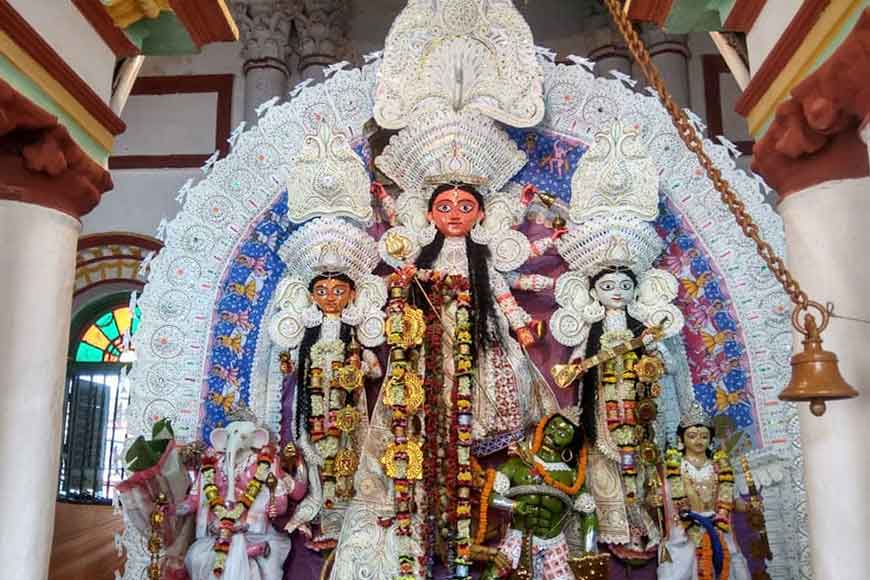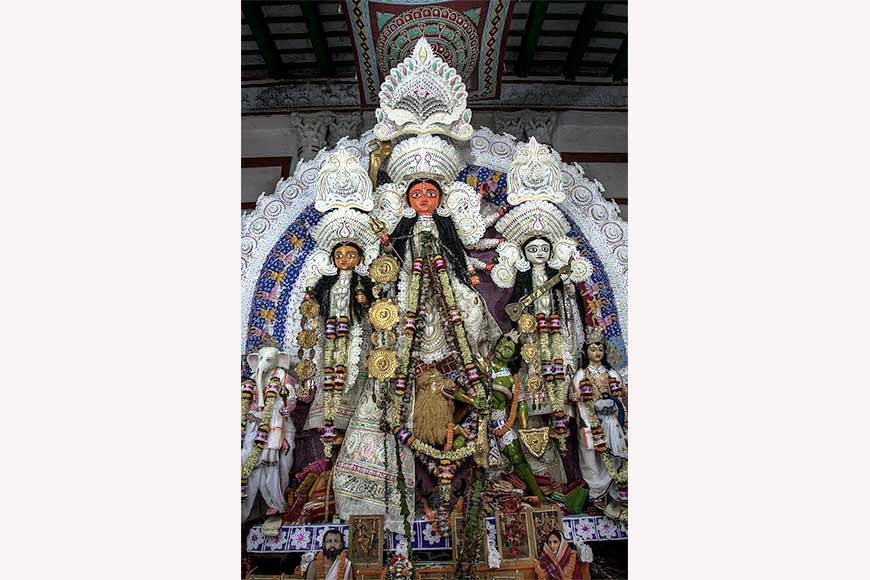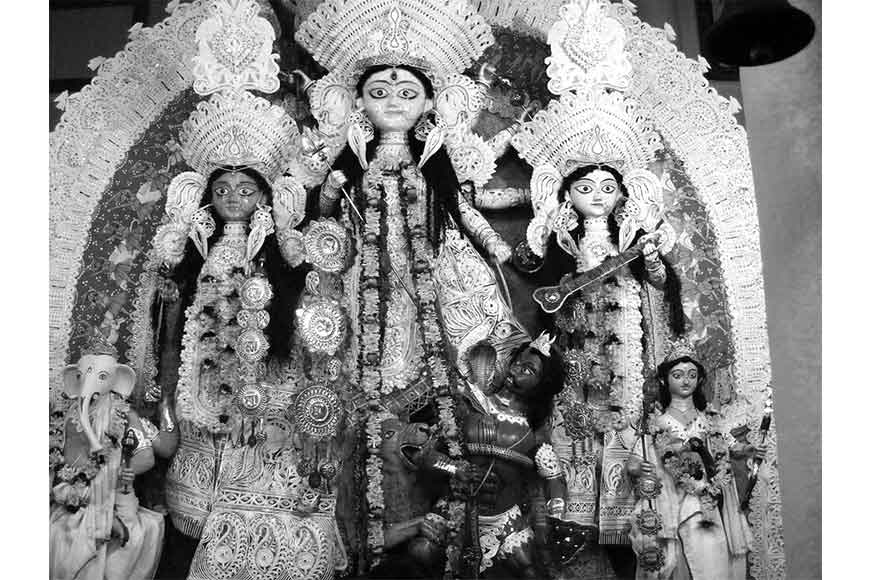AGOMONI – Why Durga’s Chalchitra of Rani Rashmoni’s zamindar house was unique?

The vast expanse of a blue sky in the horizon, kissing the sandy shores, or cotton-white clouds floating in the backdrop of kaash phool ---- any picturesque unveiling of nature is never complete without a background symphony. Blue sky to brown shores, or clouds to kaash phool ---- they all reflect a distinct parallelism that can also be drawn between Chalchitra painting and adorning the backdrop of a clay idol. Durga’s idol is never complete without the Durga Chali.
The Chalchitra is almost like a panoramic view of narratives from Hindu mythology and hence works as a running backdrop to a static idol. The art of Chalchitra flourished in parts of Bengal, from Nadia to Birbhum, Bankura, and Midnapore. The images that usually specify the space of a Durga Chalchitra are also seen on terracotta temples of Bengal. They include Devi Durga, Lord Shiva and his bull Nandi, Lord Rama and Sita, Maa Durga as Ganeh Janani or mother, with a baby Ganesha on her lap, King Daksha’s house, coronation of Lord Rama, where he and Sita are seated on a throne with Hanuman at their feet and Lakshmana, Bharata, Shatrughna, Bibhishana by their sides, scene of Krishna Leela showing Lord Krishna and Radhika with gopinis, Brahma, Vishnu, Narada, Indra and goat-headed Daksharaj and even conflict of Devi Durga with Asura Raktabij, Sumbha and Nisumbha. Though pata paintings of Bengal have been elaborately studied by erudite, scholars, and historians, unfortunately they did never include Chalchitra paintings in their research work. Will this dying art form get lost in the annals of history due to utter neglect and lack of appreciation?

Bengal art form usually has three kinds of Chali: Bangla Chali, Markin Chali and Matha Chaura Chali. The paintings differ according to Chali variations. Among few of Chali artists who still hold on to this dying art form is 88-year-old Nishupada Pal. He portrays how the four Yugs, (cosmic timeline according to Hindu mythology) are illustrated on a Chalchitra, through depiction of various deities, symbolizing a definite age. Satya Yug, (first among the four Yugas) is illustrated by Lord Shiva and Narada, Treta Yug by Lord Rama and his consort Sita, Dwapar Yug by Lord Krishna and Kali Yug, illustrated by the war between Devi Durga and two demons, Sumbha and Nisumbha.
Making of a Chalchitra needs meticulous workmanship. Old newspapers are attached to make the surface of painting and Khari maati (white primer) is applied. This is followed by pencil sketch of the composition, application of colour lining and detailing. Powdered earth colours from local stores are also used. The paintings need sheer precision of the artist in delineating the mythological characters on the Chali, infusing in them the necessary vibe.
Interestingly, the Chalchitra art form also varies from place to place. Birbhum district shows distinct characteristic features of combination of bright colours and strong, sturdy lines. Patuas of Birbhum are mostly sutradhars or carpenters and since several centuries they have continued this art form, reflecting their carpentry. While, Nadia shows confluence of Krishnanagar school of clay-modelling and painting. Figures reflect influence of clay modelling techniques and bold borders.
Chandra household of North Kolkata is a bonedi bari, that not only carries on the legacy of their century-old Durga Puja, but has preserved photographs of old Durga Chalchitra, as a proof to elaborate rendition of Hindu deities on a specified space. These photographs give us a conspicuous idea of rich and detailed indigenous art form that prevailed in ancient times. Durga idol at another bonedi bari of Kolkata --- Rani Rashmoni’s household stresses on osto sakhi and two Bastraharan scenes from Hindu mythology. The entire chalchitra is surrounded by landscapes and is made by Babla Pal, an artist from Birbhum, who also gives it exclusive ornamentation to add to its splendour.

Dutta of Dwarika Bhawan at College Street, uses a contemporary dramatic chalchitra, where a clock is drawn in the shelf of Ganesha’s mother, reflecting she is time conscious. Krishnanagar’s royal household has a notable horizontal chalchitra. Artisans set separated blocks before painting. Some households in Santipur, Nadia also paint Dakhha Raja’s royal house resembling 19th-century architecture. Significantly there exists curtains on windows.
Growing popularity of Chalchitra art in Bengal was intently connected to Indian sculptural tradition, in form and stature. The presence of Prabhabali or Shirashchakra and Prabhamandal as a backdrop to the idol is seen in stone sculptures, from Kushana and Gupta periods, and from Pala and Sena dynasties. Pala manuscript paintings, too, have similar kind of figurine and decorative motifs. The chalchitra is strewn with various Gods and Goddesses with narration of Devi Durga’s mahatya (glorification of Devi’s divine power).
 As per subjective disposition, Chalchitra in Bengal were of varied character. Earliest were Brindabani Chalchitra, depicting Lord Krishna’s magical deeds on earth, whose popularity gradually waned with time. Then came Kailashi Chalchitra of Nadia. Patuas of Krishnanagar and Shantipur excelled in making these outstanding and brilliant pieces of art. The obvious reflection of this phenomenon was seen in the works of Kumartuli school of clay-modelling in Kolkata, that flourished with the increasing pomp and show of Durga puja. Kailashi Chalchitra depicting Lord Shiva on Mount Kailasha, gained extreme popularity and is still practised. Prior to this, there were other variants, known as Brahmani Chalchitra depicting Devi Brahmani, Indrani Chal on Devi Indrani, Ramchandri Chal, Dashabatari Chal etc.
As per subjective disposition, Chalchitra in Bengal were of varied character. Earliest were Brindabani Chalchitra, depicting Lord Krishna’s magical deeds on earth, whose popularity gradually waned with time. Then came Kailashi Chalchitra of Nadia. Patuas of Krishnanagar and Shantipur excelled in making these outstanding and brilliant pieces of art. The obvious reflection of this phenomenon was seen in the works of Kumartuli school of clay-modelling in Kolkata, that flourished with the increasing pomp and show of Durga puja. Kailashi Chalchitra depicting Lord Shiva on Mount Kailasha, gained extreme popularity and is still practised. Prior to this, there were other variants, known as Brahmani Chalchitra depicting Devi Brahmani, Indrani Chal on Devi Indrani, Ramchandri Chal, Dashabatari Chal etc.
Bengal has always witnessed intermingling of various religious ideologies and thoughts, that constantly influenced its rich artistic tradition, including Chalchitra paintings, though this art form was neglected down the ages, for lack of proper patronization.









